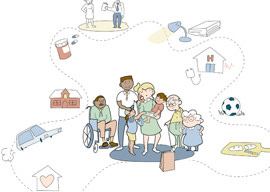
In a recent article on value-based healthcare, providers said that while their main focus is on clinical care, what happens when patients go home is largely out of their control. Social determinants, such as where a patient lives and works, their education level and social support networks, have a serious impact on outcomes. Studies have found that a third of deaths in a year in the United States were due to social factors.
Since outcomes are the key measure of value-based care, we need to build models that help providers better deal with the challenges of social determinants. Fact is, value-based healthcare is expected to expand access to care by addressing rising costs. Broader strategies must be taken to address social determinants in value-based programs to improve the overall health of the population.
To gain a better perspective on social determinants in value-based programs, we met with Dr. Karen DeSalvo, former Assistant Secretary for Health, former National Coordinator for Health Information Technology, and former Director of the Office of the National Coordinator for Health Information Technology (ONC).
The Case of Patient-Centered Outcome Measures
Medicaid, given its prominent role, has the opportunity to bridge the gap between underserved communities and healthcare. Identifying the right outcome measures is important for its success, but most measures are still based on financial or more traditional healthcare outcomes, which aren’t patient-centered. Medicaid needs to develop patient-centric outcome measures, which will help in addressing patient’s social needs. DeSalvo says that Medicaid has not entirely figured out how to be patient-centric, mainly because there has not been a financial way defined to do so. “Bottom line is that the Medicaid programs can only be mainstream if they are found to lower costs or if they are improving quality. The cost is a big driver,” says DeSalvo. For example; the 30-day readmission rate, in which providers more often than not have difficulty in determining unplanned readmission to an acute care hospital within 30 days of discharge. “In this 30-day readmission rate, even clinical excellence doesn’t help those with social needs. This is definitely one of the more worrisome things about how we measure outcomes,” says DeSalvo.
The Centers for Medicare and Medicaid Services (CMS) have taken steps towards developing patient-centered outcomes by way of evaluating some measurable standards, but progress has been slow. DeSalvo says that providers generally find it challenging to use patient-reported outcomes of any kind—digital or self-reported mainly—because the information may not always be accurate and out of context. “Self-rated health is a great way to stratify the population. To tell you who is going to need health services. But doctors don’t really want to know about it, since they don’t always know what to do with it,” she adds.
How might we improve the way we evaluate metrics? “Outcome measures don’t need to be reinvented,” says DeSalvo. “A whole suite of good outcome measures related to self-rated health do exist in the SF-36 questionnaire.” In fact, Medical Outcomes Study SF-36 has been incorporated into numerous research initiatives and is the most successful Health Related Quality of Life (HRQoL) measure in current use. But healthcare systems aren’t leaning on SF-36 as an option. “Instead, the National Quality form is trying to invent a whole suite of measures to deal with that big complex social thing.”
Models to Integrate Social Dertminants into Value-Based Care
CMS’ value-based programs reward providers for the quality of care they offer to improve population health and lower the costs. DeSalvo says there are three potential ways to adjust social determinants in value-based care programs:
First: Create an incentive model that rewards providers for addressing and assessing patients’ social needs, as opposed to using risk adjustment, which is CMS’ current approach. This proposed model would have providers assess someone’s social needs and accept that the outcomes may not be as good for low-income individuals or under-educated people.
Second: A second model could not only adjust risk, but also allow for forgiveness in outcome measures, and then provide added incentives or formulation-based payments, such as the IMPACT Act. So if an individual has social needs, the healthcare system will pay a little bit extra and in addition, to recognize that outcomes might not be good.
Third: This model will go beyond factoring social needs or determinants to be factored into the care plan; instead healthcare providers will be expected to ask structured questions and have guided interventions, in the process of closing the feedback loop, to identify and acknowledge patient impacts.
There are ongoing efforts within Medicaid to implement new models, at state and federal level, that integrate social determinants into the health care system. While most of these are still in their infancy, two interesting ones sit at both ends of the spectrum, according to DeSalvo.
The first is CMS’ health community model. And while this is an interesting approach, it falls short when providers are asked to assess social needs, refer people to services, and align resources to the community. Providers are simply untrained for social work.
The second, at the other end of the spectrum, is the New York district program. In this model, providers are not only encouraged to ask questions and refer services to patients with social needs, but also this model invests in the social services sector to optimize and digitize it—so partners on the social service side can support people in need and not just have a waiting list, which hinders access to care. “This is good population management, even though it is not improving or preventing illness. It is a good start to make sure people have the resources and support they need.” adds DeSalvo
Ethical and Legal Responsibility: The Other Side of Incorporating Social Determinants
Incorporating questions that assess social needs greatly helps physicians obtain required resources. However, asking such sensitive questions also comes with the responsibility to report the information where applicable. Things get complicated when practitioners ask for information that might affect families in a negative way. “What are the ethical and legal responsibilities to report that [information]? I haven’t seen that we have been thinking it through as yet. I worry that it is going to cause people to not really tell the truth because it may lead to losing insurance or affecting their families.”
Even though the data may not be entirely accurate, as patients may lie to protect their families, it would still benefit the system to ask sensitive questions and present information to the right stakeholders. Gathering data “is going to be messy,” says De Salvo, “but it is still the right thing to do.” She notes that this might change the way some physicians view interventions, or even alter the therapeutic process.
A logical step here would be to provide a framework or guidelines for care specialists to capture, record, and know how to act on available social needs data, as part of providing care.
Socializing the Future
Several efforts have already been initiated at federal and state level to adjust outcome measures and/or incentive structure to adjust for social determinants. To improve overall population health, including social determinants in the value-based programs is a must. To enable this, providers need education on capturing and leveraging patients’ socioeconomic factors into providing care. Payers, on the other hand, must create incentive structures that recognize patient-centered outcomes that differ from today’s norm.
The private sector is also starting to get involved. Companies like Healthify are providing solutions to payers that result in digital health and social need records for patients. Several organizations, such as Social Intervention Research and Evaluation Network (SIREN), are also leading the way to help the socially underserved populations. There’s a growing recognition across the private and public sectors of the importance of integrating social determinants into health care. The future for adjusting for social determinants in healthcare certainly looks promising.






